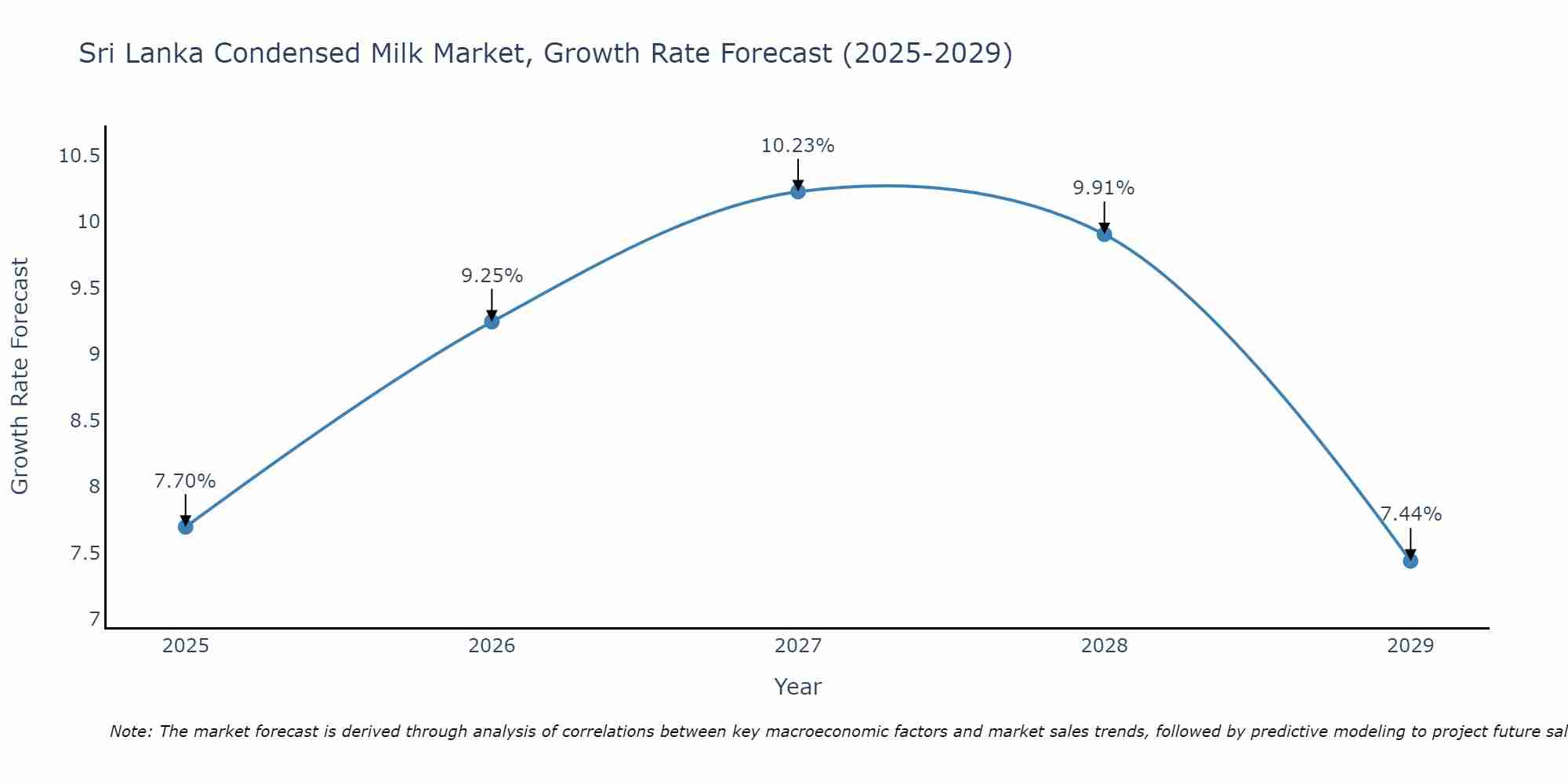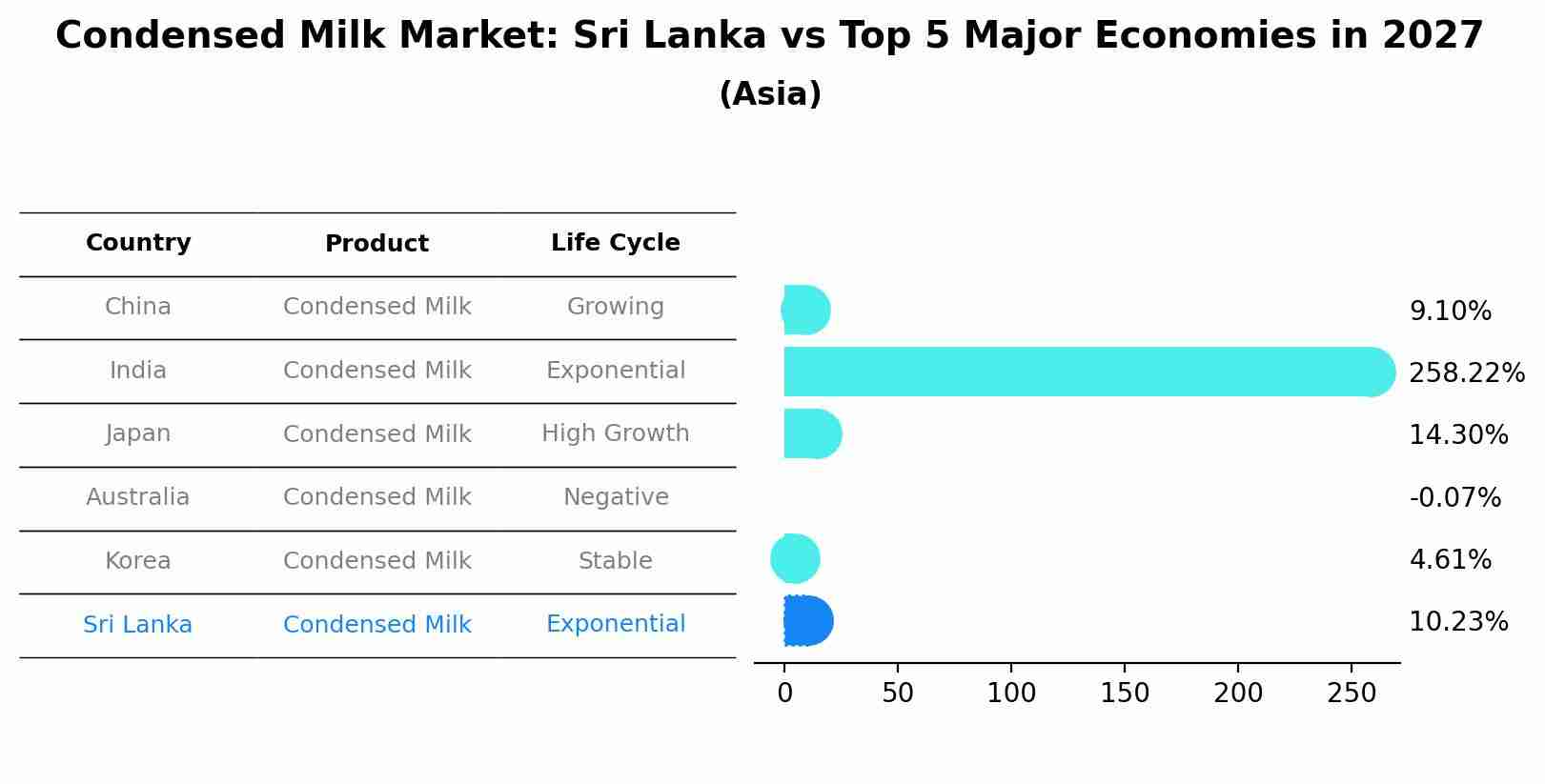Sri Lanka Condensed Milk Market (2025-2031) Outlook | Companies, Share, Analysis, Value, Forecast, Size, Trends, Industry, Growth & Revenue
| Product Code: ETC381091 | Publication Date: Aug 2022 | Updated Date: Apr 2025 | Product Type: Market Research Report | |
| Publisher: 6Wresearch | Author: Ravi Bhandari | No. of Pages: 75 | No. of Figures: 35 | No. of Tables: 20 |
Sri Lanka Condensed Milk Market Size Growth Rate
The Sri Lanka Condensed Milk Market is projected to witness mixed growth rate patterns during 2025 to 2029. Growth accelerates to 10.23% in 2027, following an initial rate of 7.70%, before easing to 7.44% at the end of the period.

Condensed Milk Market: Sri Lanka vs Top 5 Major Economies in 2027 (Asia)
The Condensed Milk market in Sri Lanka is projected to grow at a high growth rate of 10.23% by 2027, highlighting the country's increasing focus on advanced technologies within the Asia region, where China holds the dominant position, followed closely by India, Japan, Australia and South Korea, shaping overall regional demand.

Sri Lanka Condensed Milk Market Overview
The condensed milk market in Sri Lanka is a niche segment within the broader dairy industry. Condensed milk is primarily used in the preparation of desserts, traditional sweets, and beverages. The market is influenced by the rising demand for convenience foods and the popularity of condensed milk as a versatile ingredient. Key players in this market include both local manufacturers and international brands, catering to the diverse tastes and preferences of Sri Lankan consumers. The market is expected to grow as urbanization increases and more people adopt modern culinary practices.
Drivers of the market
The Sri Lanka condensed milk market is primarily driven by the growing demand for convenient and long-shelf-life dairy products. Consumers increasingly prefer condensed milk for its versatility in various culinary applications, including desserts and beverages. The market`s growth is also supported by the expanding food processing sector in Sri Lanka, which requires condensed milk as a key ingredient for a range of products.
Challenges of the market
The Sri Lanka condensed milk market faces several challenges, including fluctuating raw material prices and the dependency on imports for key ingredients. The rising cost of dairy inputs and the volatility in international dairy markets affect the pricing and supply chain stability. Additionally, the market must contend with stringent food safety regulations and the need for consistent quality control to meet both local and international standards. The competition from alternative dairy products and changing consumer preferences towards healthier, non-dairy options also pose significant threats to market growth.
Government Policy of the market
The Sri Lankan condensed milk market is influenced by government policies aimed at promoting local dairy production to reduce dependency on imports. The government has introduced subsidies and incentives for local farmers to increase milk production, and there are strict quality controls and import regulations to ensure product safety. Additionally, tariffs on imported dairy products help protect the local industry, encouraging consumers to purchase domestically produced condensed milk.
Key Highlights of the Report:
- Sri Lanka Condensed Milk Market Outlook
- Market Size of Sri Lanka Condensed Milk Market, 2024
- Forecast of Sri Lanka Condensed Milk Market, 2031
- Historical Data and Forecast of Sri Lanka Condensed Milk Revenues & Volume for the Period 2021-2031
- Sri Lanka Condensed Milk Market Trend Evolution
- Sri Lanka Condensed Milk Market Drivers and Challenges
- Sri Lanka Condensed Milk Price Trends
- Sri Lanka Condensed Milk Porter's Five Forces
- Sri Lanka Condensed Milk Industry Life Cycle
- Historical Data and Forecast of Sri Lanka Condensed Milk Market Revenues & Volume By Product Type for the Period 2021-2031
- Historical Data and Forecast of Sri Lanka Condensed Milk Market Revenues & Volume By Dairy for the Period 2021-2031
- Historical Data and Forecast of Sri Lanka Condensed Milk Market Revenues & Volume By Non-Dairy for the Period 2021-2031
- Historical Data and Forecast of Sri Lanka Condensed Milk Market Revenues & Volume By Packaging Type for the Period 2021-2031
- Historical Data and Forecast of Sri Lanka Condensed Milk Market Revenues & Volume By Cans for the Period 2021-2031
- Historical Data and Forecast of Sri Lanka Condensed Milk Market Revenues & Volume By Tubes for the Period 2021-2031
- Historical Data and Forecast of Sri Lanka Condensed Milk Market Revenues & Volume By Bottles for the Period 2021-2031
- Historical Data and Forecast of Sri Lanka Condensed Milk Market Revenues & Volume By Distribution Channel for the Period 2021-2031
- Historical Data and Forecast of Sri Lanka Condensed Milk Market Revenues & Volume By Supermarkets and Hypermarkets for the Period 2021-2031
- Historical Data and Forecast of Sri Lanka Condensed Milk Market Revenues & Volume By Convenience Stores for the Period 2021-2031
- Historical Data and Forecast of Sri Lanka Condensed Milk Market Revenues & Volume By Specialty Stores for the Period 2021-2031
- Historical Data and Forecast of Sri Lanka Condensed Milk Market Revenues & Volume By Online Retails for the Period 2021-2031
- Historical Data and Forecast of Sri Lanka Condensed Milk Market Revenues & Volume By Others for the Period 2021-2031
- Sri Lanka Condensed Milk Import Export Trade Statistics
- Market Opportunity Assessment By Product Type
- Market Opportunity Assessment By Packaging Type
- Market Opportunity Assessment By Distribution Channel
- Sri Lanka Condensed Milk Top Companies Market Share
- Sri Lanka Condensed Milk Competitive Benchmarking By Technical and Operational Parameters
- Sri Lanka Condensed Milk Company Profiles
- Sri Lanka Condensed Milk Key Strategic Recommendations
Frequently Asked Questions About the Market Study (FAQs):
- Single User License$ 1,995
- Department License$ 2,400
- Site License$ 3,120
- Global License$ 3,795
Search
Thought Leadership and Analyst Meet
Our Clients
Related Reports
- Afghanistan Apparel Market (2026-2032) | Growth, Outlook, Industry, Segmentation, Forecast, Size, Companies, Trends, Value, Share, Analysis & Revenue
- Canada Oil and Gas Market (2026-2032) | Share, Segmentation, Value, Industry, Trends, Forecast, Analysis, Size & Revenue, Growth, Competitive Landscape, Outlook, Companies
- Germany Breakfast Food Market (2026-2032) | Industry, Share, Growth, Size, Companies, Value, Analysis, Revenue, Trends, Forecast & Outlook
- Australia Briquette Market (2025-2031) | Growth, Size, Revenue, Forecast, Analysis, Trends, Value, Share, Industry & Companies
- Vietnam System Integrator Market (2025-2031) | Size, Companies, Analysis, Industry, Value, Forecast, Growth, Trends, Revenue & Share
- ASEAN and Thailand Brain Health Supplements Market (2025-2031) | Strategy, Consumer Insights, Analysis, Investment Trends, Opportunities, Growth, Size, Share, Industry, Revenue, Segments, Value, Segmentation, Supply, Forecast, Restraints, Outlook, Competition, Drivers, Trends, Demand, Pricing Analysis, Competitive, Strategic Insights, Companies, Challenges
- ASEAN Bearings Market (2025-2031) | Strategy, Consumer Insights, Analysis, Investment Trends, Opportunities, Growth, Size, Share, Industry, Revenue, Segments, Value, Segmentation, Supply, Forecast, Restraints, Outlook, Competition, Drivers, Trends, Demand, Pricing Analysis, Competitive, Strategic Insights, Companies, Challenges
- Europe Flooring Market (2025-2031) | Outlook, Share, Industry, Trends, Forecast, Companies, Revenue, Size, Analysis, Growth & Value
- Saudi Arabia Manlift Market (2025-2031) | Outlook, Size, Growth, Trends, Companies, Industry, Revenue, Value, Share, Forecast & Analysis
- Uganda Excavator, Crane, and Wheel Loaders Market (2025-2031) | Strategy, Consumer Insights, Analysis, Investment Trends, Opportunities, Growth, Size, Share, Industry, Revenue, Segments, Value, Segmentation, Supply, Forecast, Restraints, Outlook, Competition, Drivers, Trends, Demand, Pricing Analysis, Competitive, Strategic Insights, Companies, Challenges
Industry Events and Analyst Meet
Whitepaper
- Middle East & Africa Commercial Security Market Click here to view more.
- Middle East & Africa Fire Safety Systems & Equipment Market Click here to view more.
- GCC Drone Market Click here to view more.
- Middle East Lighting Fixture Market Click here to view more.
- GCC Physical & Perimeter Security Market Click here to view more.
6WResearch In News
- Doha a strategic location for EV manufacturing hub: IPA Qatar
- Demand for luxury TVs surging in the GCC, says Samsung
- Empowering Growth: The Thriving Journey of Bangladesh’s Cable Industry
- Demand for luxury TVs surging in the GCC, says Samsung
- Video call with a traditional healer? Once unthinkable, it’s now common in South Africa
- Intelligent Buildings To Smooth GCC’s Path To Net Zero


















